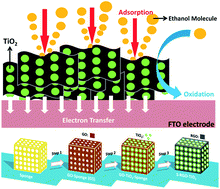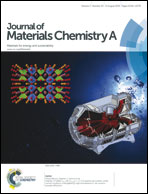Polyurethane sponge facilitating highly dispersed TiO2 nanoparticles on reduced graphene oxide sheets for enhanced photoelectro-oxidation of ethanol†
Abstract
Three-dimensional (3D) porous polyurethane sponge serves as the sacrificial scaffold for the hydrothermally-synthesized anatase TiO2-reduced graphene oxide (RGO) composites. The internal channel of the 3D polyurethane structure provides larger exposed TiO2 seeding and crystal growth area on the pre-adsorbed graphene oxide during the synthesis. The uniform pore size within the polyurethane also prevents severe aggregation of TiO2 nanoparticles. As a result, TiO2 nanoparticles are finely dispersed on the RGO sheets. In addition to the general advantages of introducing graphitic carbon to TiO2 (i.e. hydrophobic carbon for preferential organic adsorption and excellent electron transport of RGO), the presence of polyurethane sponge during the synthesis offers larger contact area between TiO2 and RGO which is facilitated by the excellent dispersion of TiO2. Besides, formation of Ti–O–C species is found at the interface and it extends the light absorption of the composite into visible light region. Combining the localized organic adsorption adjacent to TiO2, efficient charge transfer from large contact area of TiO2–RGO and the extended light response of the composite, this material demonstrates enhanced photoelectrochemical oxidation of ethanol.


 Please wait while we load your content...
Please wait while we load your content...